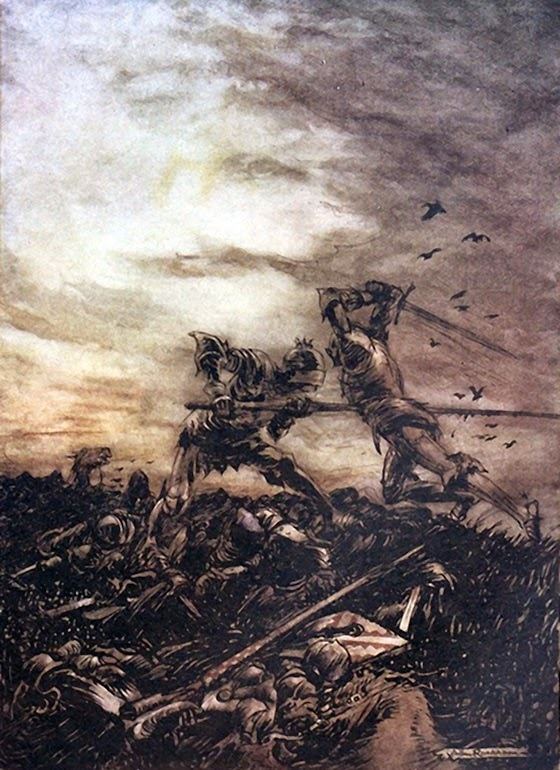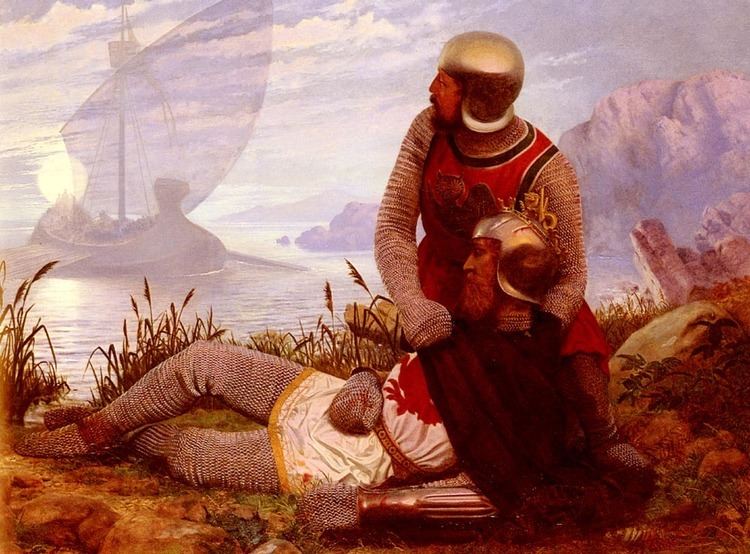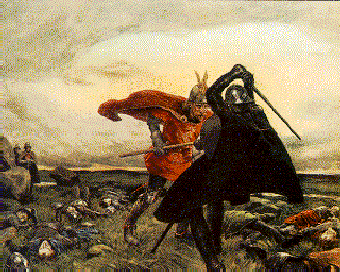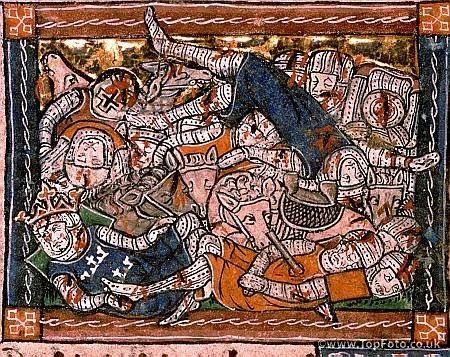Date 537 AD | ||
 | ||
Results Arthurian victory, but indecisive, no effective succession Similar Battle of Badon, Battle of Catraeth, Battle of Deorham | ||
The arthurian battle of camlann gets underway ca ad 537
The Battle of Camlann (Welsh: Gwaith Camlan or Brwydr Camlan) is reputed to have been the final battle of King Arthur, in which he either died or was fatally wounded, fighting either with or against Mordred who is also said to have died.
Contents
- The arthurian battle of camlann gets underway ca ad 537
- Historicity
- Etymology
- Legendary versions
- References

Historicity

The earliest known reference to the battle of Camlann is an entry in the 10th-century Annales Cambriae, recording the battle in the year 537. It mentions Mordred (Medraut), but it does not specify that he and Arthur fought on opposite sides.
Gueith camlann in qua Arthur et Medraut corruerunt.(The Strife of Camlann in which Arthur and Medraut (Mordred) perished.)Andrew Breeze writes:

Last of all, what can we conclude about Camlan itself? Can we say anything at all on its location, significance, and even whether it happened or not? Here we may recall the views expressed by Padel, Dark, Dumville, and Higham. All are skeptics, variously declaring that the Annales Cambriae entry for Camlan can be taken seriously only by the 'no smoke without fire' school of thinking (OJP), that it provides 'no evidence whatsoever for a prototypical Arthur' (KD), and that as a record it is 'unverifiable' if not 'entirely unhistorical' (NH).

The status of the entry for 537 is therefore now clear. On the one hand it is presented as sober fact and appears in the context of persons known to history (Irish saints, Maelgwn Gwynedd, Gildas). On the other, we cannot be certain that it is old; and the circumstance that, by the tenth century, Arthur had long been the creature of fable must subvert its authority. The historical Arthur thus becomes little more than a wisp of air. Unless unexpected evidence turns up, the only honest answer we can give here is that of Kenneth Jackson, that 'We do not know, but he may well have existed.'
The location described as Camlann is unknown.
Etymology
The name may derive from a Brittonic *Cambo-landa ("crooked-enclosure"), or (less likely) *Cambo-glanna ("crooked bank (of a river)"), as found in the name of the Roman fort of Camboglanna.
Legendary versions
Later accounts of the battle, much embroidered, appear in Geoffrey of Monmouth's Historia Regum Britanniae and the Alliterative Morte Arthure. Some sources state that the battle was caused by King Arthur's return to Camelot, after his quest to hunt down Sir Lancelot. King Arthur had learned of Guinevere and Sir Lancelot's affair, and Sir Lancelot fled to France. Arthur pursued him in an effort to get revenge; and his enemy, Mordred, took over Britain. When Arthur returned and tried to take back his kingdom, Mordred refused. A battle erupted, and Arthur was severely wounded. He journeyed to the isle of Avalon, which is said to have magical properties, in hope that he could be healed. Some say he died there, and some say his wounds healed and he is waiting to be reincarnated.
Welsh triads offer clues to the alleged cause of the Battle of Camlann. Triad 51 reflects (and is most likely derived from) Geoffrey of Monmouth: Medrawd (Mordred) rebels against Arthur while the latter is campaigning on the Continent and usurps the throne, instigating the battle of Camlann. Triad 53 lists a slap Gwenhwyvach gave to her sister Gwenhwyfar, wife of Arthur, as one of the "Three Harmful Blows of the Island of Britain", causing the Strife of Camlann. Calling Camlann one of Britain's "Three Futile Battles", Triad 84 also mentions this dispute between sisters. Triad 54 describes Medrawd (Mordred) raiding Arthur's court, throwing Gwenhwyfar to the ground and beating her. Other Triads in which Camlann is mentioned include numbers 30 ("Three Faithless War Bands"), 59 ("Three Unfortunate Counsels"), 84 ("Three Futile Battles").
